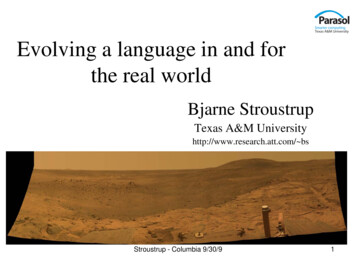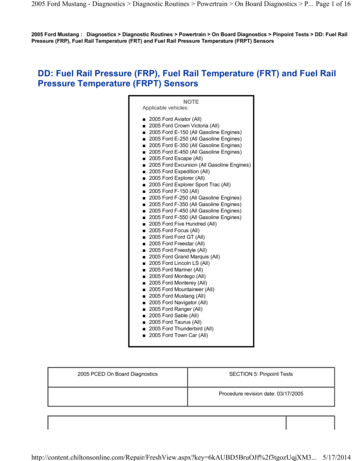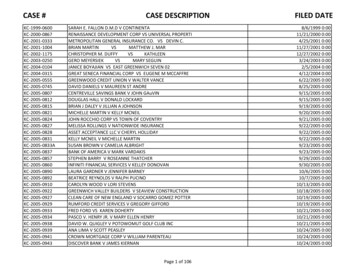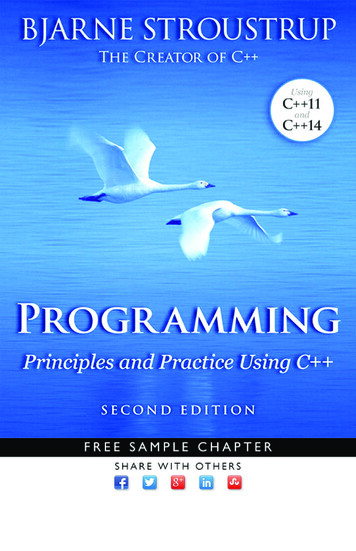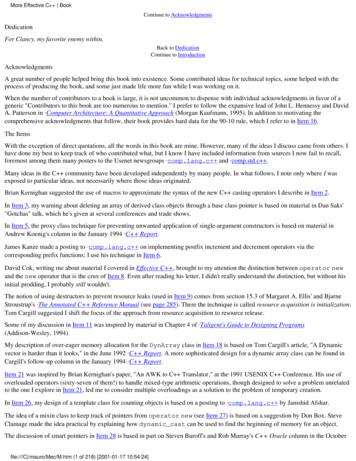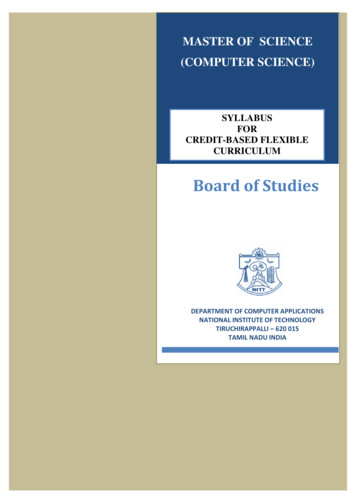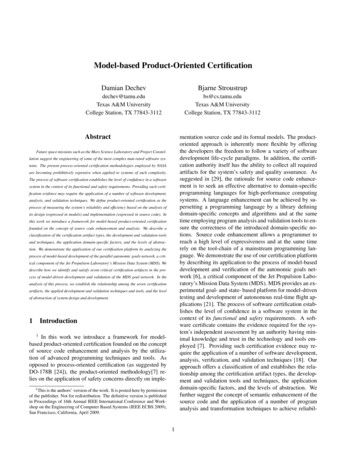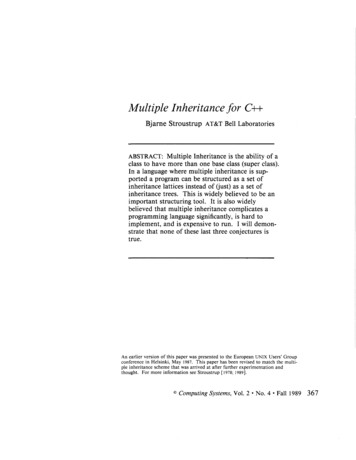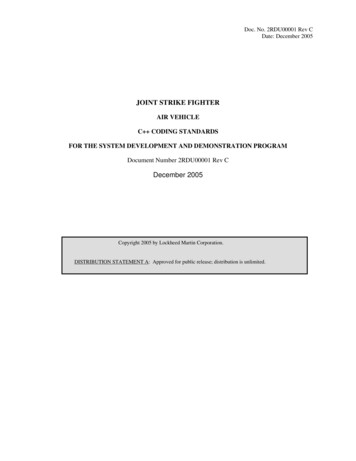
Transcription
Doc. No. 2RDU00001 Rev CDate: December 2005JOINT STRIKE FIGHTERAIR VEHICLEC CODING STANDARDSFOR THE SYSTEM DEVELOPMENT AND DEMONSTRATION PROGRAMDocument Number 2RDU00001 Rev CDecember 2005Copyright 2005 by Lockheed Martin Corporation.DISTRIBUTION STATEMENT A: Approved for public release; distribution is unlimited.
Doc. No. 2RDU00001 Rev CDate: December 2005This page intentionally left blank3
Doc. No. 2RDU00001 Rev CDate: December 2005TABLE OF CONTENTS123Introduction. 7Referenced Documents . 8General Design. 103.1Coupling & Cohesion . 113.2Code Size and Complexity. 124C Coding Standards. 134.1Introduction. 134.2Rules . 134.2.1Should, Will, and Shall Rules . 134.2.2Breaking Rules. 134.2.3Exceptions to Rules. 144.3Terminology. 144.4Environment. 174.4.1Language. 174.4.2Character Sets . 174.4.3Run-Time Checks . 184.5Libraries . 194.5.1Standard Libraries. 194.6Pre-Processing Directives . 204.6.1#ifndef and #endif Pre-Processing Directives. 204.6.2#define Pre-Processing Directive. 214.6.3#include Pre-Processing Directive. 214.7Header Files . 224.8Implementation Files . 234.9Style . 234.9.1Naming Identifiers . 244.9.1.1 Naming Classes, Structures, Enumerated types and typedefs . 254.9.1.2 Naming Functions, Variables and Parameters . 264.9.1.3 Naming Constants and Enumerators. 264.9.2Naming Files. 264.9.3Classes. 274.9.4Functions. 274.9.5Blocks . 284.9.6Pointers and References. 284.9.7Miscellaneous . 284.10 Classes. 294.10.1Class Interfaces . 294.10.2Considerations Regarding Access Rights . 294.10.3Member Functions . 294.10.4const Member Functions. 304.10.5Friends. 304.10.6Object Lifetime, Constructors, and Destructors . 304.10.6.1Object Lifetime . 304.10.6.2Constructors . 314.10.6.3Destructors . 324.10.7Assignment Operators. 334
Doc. No. 2RDU00001 Rev CDate: December 20054.10.8Operator Overloading . 334.10.9Inheritance. 344.10.10Virtual Member Functions. 374.11 Namespaces. 384.12 Templates. 394.13 Functions. 404.13.1Function Declaration, Definition and Arguments. 404.13.2Return Types and Values . 414.13.3Function Parameters (Value, Pointer or Reference) . 424.13.4Function Invocation . 424.13.5Function Overloading . 434.13.6Inline Functions . 434.13.7Temporary Objects. 444.14 Comments . 444.15 Declarations and Definitions. 464.16 Initialization . 474.17 Types. 484.18 Constants. 484.19 Variables . 494.20 Unions and Bit Fields. 504.21 Operators. 514.22 Pointers & References. 524.23 Type Conversions . 544.24 Flow Control Structures. 564.25 Expressions . 584.26 Memory Allocation. 594.27 Fault Handling . 594.28 Portable Code. 604.28.1Data Abstraction . 604.28.2Data Representation . 604.28.3Underflow/Overflow. 614.28.4Order of Execution. 614.28.5Pointer Arithmetic. 614.29 Efficiency Considerations. 624.30 Miscellaneous . 625Testing. 635.1.1Subtypes. 635.1.2Structure. 63Appendix A. 66Appendix B (Compliance) . 1425
Doc. No. 2RDU00001 Rev CDate: December 2005Table 1. Change LogRevisionID0001 Rev B0001 Rev CDocumentDateOct 2005Nov 2005ChangeAuthorityK. CarrollK. CarrollAffectedParagraphsAllChange log - AddedSection 1, point 3Rule 52Rule 76Rule 91Rule 93Rule 129Rule 167Rule 218Appendix A, Rule 3Table 2Rule 159 - clarify that"unary &" is intended.Rule 32 - clarification ofthe scope of the rule. Also,example added in appendixfor rule 32.CommentsOriginalAdd change log.Corrected spellingerrors.Both binary and unaryforms of "&" exist.Clarification is addedto specify that the ruleis concerned with theunary form.The rule does notapply to a particularpartitioning oftemplate classes andfunctions.6
Doc. No. 2RDU00001 Rev CDate: December 20051 INTRODUCTIONThe intent of this document is to provide direction and guidance to C programmers that willenable them to employ good programming style and proven programming practices leading tosafe, reliable, testable, and maintainable code. Consequently, the rules contained in thisdocument are required for Air Vehicle C development1 and recommended for non-AirVehicle C development.As indicated above, portions of Air Vehicle (AV) code will be developed in C . C wasdesigned to support data abstraction, object-oriented programming, and generic programmingwhile retaining compatibility with traditional C programming techniques. For this reason, theAV Coding Standards will focus on the following:1. Motor Industry Software Reliability Association (MISRA) Guidelines For The Use OfThe C Language In Vehicle Based Software,2. Vehicle Systems Safety Critical Coding Standards for C, and3. C language-specific guidelines and standards.The MISRA Guidelines were written specifically for use in systems that contain a safety aspectto them. The guidelines address potentially unsafe C language features, and provideprogramming rules to avoid those pitfalls. The Vehicle Systems Safety Critical Coding Standardsfor C, which are based on the MISRA C subset, provide a more comprehensive set of languagerestrictions that are applied uniformly across Vehicle Systems safety critical applications. TheAV Coding Standards build on the relevant portions of the previous two documents with anadditional set of rules specific to the appropriate use C language features (e.g. inheritance,templates, namespaces, etc.) in safety-critical environments.Overall, the philosophy embodied by the rule set is essentially an extension of C ’s philosophywith respect to C. That is, by providing “safer” alternatives to “unsafe” facilities, knownproblems with low-level features are avoided. In essence, programs are written in a “safer”subset of a superset.1TBD: Required for Air Vehicle non-prime teams?7
Doc. No. 2RDU00001 Rev CDate: December 20052 REFERENCED DOCUMENTS1. ANSI/IEEE Std 754, IEEE Standard for Binary Floating-Point Arithmetic, 1985.2. Bjarne Stroustrup. The C Programming Language, 3rd Edition. Addison-Wesley,2000.3. Bjarne Stroustrup. Bjarne Stroustrup's C Glossary.4. Bjarne Stroustrup. Bjarne Stroustrup's C Style and Technique FAQ.5. Barbara Liskov. Data Abstraction and Hierarchy, SIGPLAN Notices, 23, 5 (May, 1988).6. Scott Meyers. Effective C : 50 Specific Ways to Improve Your Programs and Design,2nd Edition. Addison-Wesley, 1998.7. Scott Meyers. More Effective C : 35 New Ways to Improve Your Programs andDesigns. Addison-Wesley, 1996.8. Motor Industry Software Reliability Association. Guidelines for the Use of the CLanguage in Vehicle Based Software, April 1998.9. ISO/IEC 10646-1, Information technology - Universal Multiple-Octet Coded CharacterSet (UCS) - Part 1: Architecture and Basic Multilingual Plane, 1993.10. ISO/IEC 14882:2003(E), Programming Languages – C . American National StandardsInstitute, New York, New York 10036, 2003.11. ISO/IEC 9899: 1990, Programming languages - C, ISO, 1990.12. JSF Mission Systems Software Development Plan.13. JSF System Safety Program Plan. DOC. No. 2YZA00045-0002.14. Programming in C Rules and Recommendations.Copyright by Ellemtel Telecommunication Systems LaboratoriesBox 1505, 125 25 Alvsjo, SwedenDocument: M 90 0118 Uen, Rev. C, 27 April 1992.Used with permission supplied via the following statement:Permission is granted to any individual or institution to use, copy, modify and distributethis document, provided that this complete copyright and permission notice is maintainedintact in all copies.8
Doc. No. 2RDU00001 Rev CDate: December 200515. RTCA/DO-178B, Software Considerations in Airborne Systems and EquipmentCertification, December 1992.9
Doc. No. 2RDU00001 Rev CDate: December 20053 GENERAL DESIGNThis coding standards document is intended to help programmers develop code that conforms tosafety-critical software principles, i.e., code that does not contain defects that could lead tocatastrophic failures resulting in significant harm to individuals and/or equipment. In general, thecode produced should exhibit the following important qualities:Reliability: Executable code should consistently fulfill all requirements in a predictable manner.Portability: Source code should be portable (i.e. not compiler or linker dependent).Maintainability: Source code should be written in a manner that is consistent, readable, simplein design, and easy to debug.Testability: Source code should be written to facilitate testability. Minimizing the followingcharacteristics for each software module will facilitate a more testable and maintainable module:1. code size2. complexity3. static path count (number of paths through a piece of code)Reusability: The design of reusable components is encouraged. Component reuse can eliminateredundant development and test activities (i.e. reduce costs).Extensibility: Requirements are expected to evolve over the life of a product. Thus, a systemshould be developed in an extensible manner (i.e. perturbations in requirements may be managedthrough local extensions rather than wholesale modifications).Readability: Source code should be written in a manner that is easy to read, understand andcomprehend.Note that following the guidelines contained within this document will not guarantee theproduction of an error-free, safe product. However, adherence to these guidelines, as well as theprocesses defined in the Software Development Plan [12], will help programmers produce cleandesigns that minimize common sources of mistakes and errors.10
Doc. No. 2RDU00001 Rev CDate: December 20053.1 Coupling & CohesionCoupling and cohesion are properties of a system that has been decomposed into modules.Cohesion is a measure of how well the parts in the same module fit together. Coupling is ameasure of the amount of interaction between the different modules in a system. Thus, cohesiondeals with the elements within a module (how well-suited elements are to be part of the samemodule) while coupling deals with the relationships among modules (how tightly modules areglued together).Object-oriented design and implementation generally support desirable coupling and cohesioncharacteristics. The design principles behind OO techniques lead to data cohesion withinmodules. Clean interfaces between modules enable the modules to be loosely coupled.Moreover, data encapsulation and data protection mechanisms provide a means to help enforcethe coupling and cohesion goals.Source code should be developed as a set of modules as loosely coupled as is reasonablyfeasible. Note that generic programming (which requires the use of templates) allows sourcecode to be written with loose coupling and without runtime overhead.Examples of tightly coupled software would include the following: many functions tied closely to hardware or other external software sources, andmany functions accessing global data.There may be times where tightly coupled software is unavoidable, but its use should be bothminimized and localized as suggested by the following guidelines: limit hardware and external software interfaces to a small number of functions,minimize the use of global data, andminimize the exposure of implementation details.11
Doc. No. 2RDU00001 Rev CDate: December 20053.2 Code Size and ComplexityAV Rule 1Any one function (or method) will contain no more than 200 logical source lines of code (LSLOCs).Rationale: Long functions tend to be complex and therefore difficult to comprehend and test.Note: Section 4.2.1 defines should and shall rules as well the conditions under whichdeviations from should or shall rules are allowed.AV Rule 2There shall not be any self-modifying code.Rationale: Self-modifying code is error-prone as well as difficult to read, test, and maintain.AV Rule 3All functions shall have a cyclomatic complexity number of 20 or less.Rationale: Limit function complexity. See AV Rule 3 in Appendix A for additional details.Exception: A function containing a switch statement with many case labels may exceed thislimit.Note: Section 4.2.1 defines should and shall rules as well the conditions under whichdeviations from should or shall rules are allowed.12
Doc. No. 2RDU00001 Rev CDate: December 20054 C CODING STANDARDS4.1 IntroductionThe purpose of the following rules and recommendations is to define a C programming stylethat will enable programmers to produce code that is more: correct,reliable, andmaintainable.In order to achieve these goals, programs should: have a consistent style,be portable to other architectures,be free of common types of errors, andbe understandable, and hence maintainable, by different programmers.4.2 Rules4.2.1Should, Will, and Shall RulesThere are three types of rules: should, will, and shall rules. Each rule contains either a“should”, “will” or a “shall” in bold letters indicating its type. 4.2.2Should rules are advisory rules. They strongly suggest the recommended way ofdoing things.Will rules are intended to be mandatory requirements. It is expected that they will befollowed, but they do not require verification. They are limited to non-safety-criticalrequirements that cannot be easily verified (e.g., naming conventions).Shall rules are mandatory requirements. They must be followed and they requireverification (either automatic or manual).Breaking RulesAV Rule 4To break a “should” rule, the following approval must be received by the developer: approval from the software engineering lead (obtained by the unit approval in thedevelopmental CM tool)AV Rule 5To break a “will” or a “shall” rule, the following approvals must be received by thedeveloper: approval from the software engineering lead (obtained by the unit approval in thedevelopmental CM tool)approval from the software product manager (obtained by the unit approval in thedevelopmental CM tool)13
Doc. No. 2RDU00001 Rev CDate: December 2005AV Rule 6Each deviation from a “shall” rule shall be documented in the file that contains thedeviation). Deviations from this rule shall not be allowed, AV Rule 5 notwithstanding.4.2.3Exceptions to RulesSome rules may contain exceptions. If a rule does contain an exception, then approval is notrequired for a deviation allowed by that exceptionAV Rule 7Approval will not be required for a deviation from a “shall” or “will” rule that complieswith an exception specified by that rule.4.3 Terminology1. An abstract base class is a class from which no objects may be created; it is only used asa base class for the derivation of other classes. A class is abstract if it includes at least onemember function that is declared as pure virtual.2. An abstract data type is a type whose internal form is hidden behind a set of accessfunctions. Objects of the type are created and inspected only by calls to the accessfunctions. This allows the implementation of the type to be changed without requiringany changes outside the module in which it is defined.3. An accessor function is a function which returns the value of a data member.4. A catch clause is code that is executed when an exception of a given type is raised. Thedefinition of an exception handler begins with the keyword catch.5. A class is a user-defined data type which consists of data elements and functions whichoperate on that data. In C , this may be declared as a class; it may also be declared as astruct or a union. Data defined in a class is called member data and functions defined in aclass are called member functions.6. A class template defines a family of classes. A new class may be created from a classtemplate by providing values for a number of arguments. These values may be names oftypes or constant expressions.7. A compilation unit is the source code (after preprocessing) that is submitted to acompiler for compilation (including syntax checking).8. A concrete type is a type without virtual functions, so that objects of the type can beallocated on the stack and manipulated directly (without a need to use pointers orreferences to allow the possibility for derived classes). Often, small self-containedclasses. [3]9. A constant member function is a function which may not modify data members.10. A constructor is a function which initializes an object.14
Doc. No. 2RDU00001 Rev CDate: December 200511. A copy constructor is a constructor in which the first argument is a reference to anobject that has the same type as the object to be initialized.12. Dead code is “executable object code (or data) which, as a result of a design error cannotbe executed (code) or used (data) in an operational configuration of the target computerenvironment and is not traceable to a system or software requirement.” [9]13. A declaration of a variable or function announces the properties of the variable orfunction; it consists of a type name and then the variable or function name. Forfunctions, it tells the compiler the name, return type and parameters. For variables, ittells the compiler the name and type.int32 fahr;int32 foo ();14. A default constructor is a constructor which needs no arguments.15. A definition of a function tells the compiler how the function works. It shows whatinstructions are executed for the function.int32 foo (){// Statements}16. An enumeration type is an explicitly declared set of symbolic integer constants. In C it is declared as an enum.17. An exception is a run-time program anomaly that is detected in a function or memberfunction. Exception handling provides for the uniform management of exceptions.18. A forwarding function is a function which does nothing more than call another function.19. A function template defines a family of functions. A new function may be created froma function template by providing values for a number of arguments. These values may benames of types or constant expressions.20. An identifier is a name which is used to refer to a variable, constant, function or type inC . When necessary, an identifier may have an internal structure which consists of aprefix, a name, and a suffix (in that order).21. An iterator is an object that con be used to traverse a data structure.22. A macro is a name for a text string which is defined in a #define statement. When thisname appears in source code, the compiler replaces it with the defined text string.23. Multiple inheritance is the derivation of a new class from more than one base class.15
Doc. No. 2RDU00001 Rev CDate: December 200524. A mutator function is a function which sets the value of a data member.25. The one definition rule - there must be exactly one definition of each entity in aprogram. If more than one definition appears, say because of replication through headerfiles, the meaning of all such duplicates must be identical. [3]26. An overloaded function name is a name which is used for two or more functions ormember functions having different argument types.27. An overridden member function is a member function in a base class which is redefined in a derived class.28. A built-in data type is a type which is defined in the language itself, such as int.29. Protected members of a class are member data and member functions which areaccessible by specifying the name within member functions of derived classes.30. Public members of a class are member data and member functions which are accessibleeverywhere by specifying an instance of the class and the name.31. A pure virtual function is one with an initializer 0 in its declaration. Making a virtualfunction pure makes the class abstract. A pure virtual function must be overridden in atleast one derived class.32. A reference is another name for a given variable. In C , the ‘address of’ (&) operator isused immediately after the data type to indicate that the declared variable, constant, orfunction argument is a reference.33. The scope of a name refers to the context in which it is visible. [Context, here, means thefunctions or blocks in which a given variable name can be used.]34. A side effect is the change of a variable as a by-product of an evaluation of anexpression.35. A structure is a user-defined type for which all members are public by default.36. A typedef is another name for a data type, specified in C using a typedef declaration.37. Unqualified type is a type that does not have const or volatile as a qualifier.38. A user-defined data type is a type which is defined by a programmer in a class, struct,union, or enum definition or as an instantiation of a class template.16
Doc. No. 2RDU00001 Rev CDate: December 20054.4 Environment4.4.1LanguageAV Rule 8All code shall conform to ISO/IEC 14882:2002(E) standard C . [10]Rationale: ISO/IEC 14882 is the international standard that defines the C programminglanguage. Thus all code shall be well-defined with respect to ISO/IEC 14882. Any languageextensions or variations from ISO/IEC 14882 shall not be allowed.4.4.2Character SetsNote that the rules in this section may need to be modified if one or more foreign languages willbe used for input/output purposes (e.g. displaying information to pilots).AV Rule 9 (MISRA Rule 5, Revised)Only those characters specified in the C basic source character set will be used. This setincludes 96 characters: the space character, the control characters representing horizontal tab,vertical tab, form feed, and newline, and the following 91 graphical characters:aA0/bB1{ cC2}&dD3[ eE4] fF5#!gG6( hH7),iI8 \jJ9 "k l m n o p q r s t u v w x y zK L M N O P Q R S T U V W X Y Z% : ; . ? * ’Rationale: Minimal required character set.AV Rule 10(MISRA Rule 6)Values of character types will be restricted to a defined and documented subset of ISO10646-1. [9]Rationale: 10646-1 represents an international standard for character mapping. For the basicsource character set, the 10646-
enable them to employ good programming style and proven programming practices leading to safe, reliable, testable, and maintainable code. Consequently, the rules contained in this . New York, New York 10036, 2003. 11. ISO/IEC 9899: 1990, . There may be times where tightly coupled software is unavoidable, but its use should be both .
